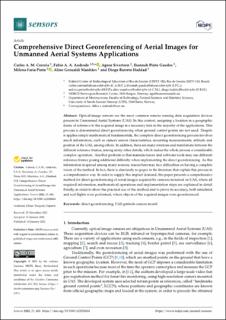| dc.description.abstract | Optical image sensors are the most common remote sensing data acquisition devices present in Unmanned Aerial Systems (UAS). In this context, assigning a location in a geographic frame of reference to the acquired image is a necessary task in the majority of the applications. This process is denominated direct georeferencing when ground control points are not used. Despite it applies simple mathematical fundamentals, the complete direct georeferencing process involves much information, such as camera sensor characteristics, mounting measurements, attitude and position of the UAS, among others. In addition, there are many rotations and translations between the different reference frames, among many other details, which makes the whole process a considerable complex operation. Another problem is that manufacturers and software tools may use different reference frames posing additional difficulty when implementing the direct georeferencing. As this information is spread among many sources, researchers may face difficulties on having a complete vision of the method. In fact, there is absolutely no paper in the literature that explain this process in a comprehensive way. In order to supply this implicit demand, this paper presents a comprehensive method for direct georeferencing of aerial images acquired by cameras mounted on UAS, where all required information, mathematical operations and implementation steps are explained in detail. Finally, in order to show the practical use of the method and to prove its accuracy, both simulated and real flights were performed, where objects of the acquired images were georeferenced | |

